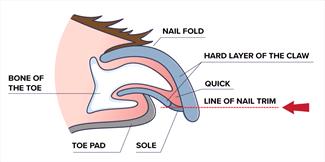When your dog’s nails get too long, it can affect their health and overall comfort. Overgrown nails are more prone to nail breakage and injury. Over time, too-long nails can keep your dog from placing their feet correctly as they walk or run, and broken nails can get snagged in carpet.
You’ve watched the staff at your veterinarian's office trim your dog’s (or cat’s) nails many times. Your well-trained dog has no problem with nail clippers and is always cooperative with the technicians, so how hard can this be?
If you aren’t planning to visit the veterinarian for any other reason, you think, why go in just for a quick nail trim?
So, you have corralled the needed tools for the job, which in your mind are:
1. your dog; and
2. the nail clippers.
As expected, your always-calm dog sniffs the clippers and holds their paw up for you to begin. Clearly, this is not a big deal. You grasp the paw in your hand and gently expose the first toenail by squeezing a bit. You put the trimmer around the nail and squeeze the handles. With a satisfying click, you see the nail trimming pop away, and at the very same moment, your sweet dog lets out a sharp yelp, frightening you both. And there is blood.
Blood? Why is there blood? That never happens when the veterinarian technician does the nail trimming.
Your very good dog is still sitting there, looking at you with what you think is betrayed reproach. What now? Panic? No.
Diagram of dog's toenail

Diagram of dog's toenail
Nail Trim Essentials
Let’s back up.
Let’s return to the last time the veterinary technician trimmed your dog’s nails. This time, really watch the process and ask questions, such as, how short should you trim the nails?
If you aren’t familiar with the term “quick”, it refers to the blood and nerve-filled nail bed. If nails are clipped too short, the quick is nicked, and the nail will bleed. If your dog has fairly clear nails, you can see the quick. If there is an assortment of clear and dark nails, you can judge where the quick might be on the dark ones by looking at a clear nail.
There is a theory that when nails are trimmed or broken, the quick recedes further up the nail. Therefore the“quick line” may not be the same on every nail. If your dog or cat has a nail that seems ragged or shorter than the rest or has a bit of dried blood on it, this nail may have been torn previously. Keep in mind that this nail may not need as much trimming as the longer ones. However, it’s a good idea to clean it up to avoid further tearing.
So, you feel more confident trimming your dog or cat’s nails, right?
Handling “Quicked” Nails:
But now you know that things can happen, and you have revised your list of tools. You gather:
- your dog (or cat);
- nail clippers;
- clean towel;
- a paper plate or small dish; and
- a coagulant to help stop any bleeding.
Over-the-counter coagulants to stop nail bleeding are readily available. Styptic powder is the most common substance used for this type of first aid. Made from natural ingredients, including potassium aluminum sulfate (alum) and diatomaceous earth, styptic powder can be used on minor cuts and toenails. It’s safe for use on pets.
You can find styptic powder at any pet supply store. Your veterinarian probably carries it if the clinic sells over-the-counter products. Corn starch will also stop bleeding effectively, and baking powder or flour can be used as a second choice. Keep styptic powder or one of these products on hand with your nail-clipping supplies.
If a toenail does start to bleed, press the clean towel against the nail and hold it firmly for a few moments. Remove the towel and press the bleeding nail into some coagulant powder you’ve already prepared by pouring it onto the paper towel or dish. Use your fingers to pinch some powder to pack into the nail. Continue to hold the towel firmly around the toe.
You could also use a cotton-tipped applicator with styptic powder on the end and hold that firmly to the toenail.
A few minutes of this will likely stop the bleeding, but if it doesn’t, continue the pressure with the towel and reapply the styptic powder.
If your pet isn’t exactly the quiet dog described here, have someone help you by holding your dog or cat. A trusted pet holder can help calm an upset animal and keep the affected foot still, helping to avoid a mess if your pet flings their paw around. Make sure you have trained your pet prior to beginning nail trims. Food distractions may also be helpful.
While uncomfortable for your pet, a toenail trimmed too short and bleeding is not necessarily an emergency. You will become more confident trimming your pet’s nails and less likely to nip the quick the more times you do it. If the bleeding continues for longer than 10 minutes or is very heavy, call your veterinarian.
On rare occasions, your dog may need to be seen by a veterinarian to assess why a nail is bleeding excessively, and sometimes an injured or broken toenail must be removed in order to heal properly.
Janet Stomberg, B.S, M.S., and Pegi Webster, VIN Editor, contributed to this article.